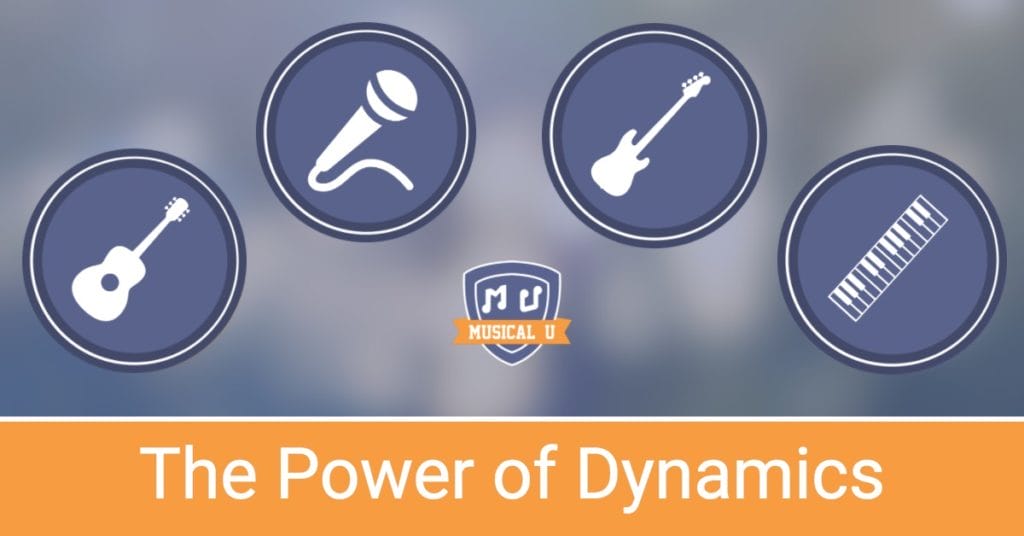In simple terms, “dynamics” just means how loud or soft each note is. But don’t let that simple definition fool you. Dynamics are one of the richest tools a musician has to bring expressiveness to their performance and add their own style to a piece of music.
In this month’s Instrument Packs we looked at this important but often-overlooked topic: the power of dynamics!
Guitar
In the guitar pack Resident Pro Dylan Welsh covers three different ways you can control your dynamics effectively, with each hand and also your equipment.
Including:
- Use of the right hand in playing single note lines, and how to make a simple adjustment to your technique and mindset to give you more control over your dynamics.
- Use of the left hand in playing chords, in order to reduce the size of your voicings and help you sit back in a mix.
- Use of your equipment to dial in your setup in a way that will allow you the maximum amount of dynamic control.
- Practice MP3s covering a dynamic scale exercise and the altered chord voicings covered.
If you’ve ever felt like strumming through chords was a bit dull or your solos were a bit monotonous then this pack will show you a way to bring new life and interest to it in a variety of ways!
Piano
Resident Pro for piano, Sara Campbell, approaches the topic of dynamics in terms of storytelling and what a musician can accomplish musically through effective use of dynamics, and she shares exercises you can use to develop your skill with both the core techniques and the musical application of dynamics.
Including:
- Dynamic Overview: A quick run-down of Italian dynamic signs and terms that you may come across in sheet music.
- Storytelling with Dynamics: What we can learn from acting and script analysis when it comes to dynamics, and how we can apply these concepts to enhance our own storytelling abilities at the piano.
- Messa di voce: A simple dynamic exercise based on a term that comes from the Italian school of singing.
- MP3 Practice tracks demonstrating and providing backing for the dynamic exercises covered.
Although any pianist can and should learn to accurately reproduce the intended dynamic levels in a piece, from pianissimo to fortissimo and beyond, you’ll take your playing to another level of musicality when you learn to really use dynamics in your own way to bring the music to life.
Bass
Steve Lawson our Resident Pro for bass breaks down the topic of dynamics into control and variation, how you can and should train your fingers (and ears) to produce exactly the volumes you intend to bring out the desired musical expression on bass.
Including:
- Dynamic Control: Fingering techniques that will create accented and unaccented notes.
- Dynamic Variation: Levels of dynamics and playing techniques that can produce different dynamic results.
- Mechanical Control: How to use equipment to control dynamics.
- Practice MP3s demonstrating techniques used for dynamics for you to practice with.
Bassists are often underappreciated when it comes to dynamics due to the widespread reliance on compressor pedals and expectation that notes are as consistent and unvaried dynamically as possible – but Steve cracks that assumption wide open and shows what’s really possible for you.
Singing
In our singing pack guest Pro Nina Rosenberger shares exercises you can use to more accurately and easily control your volume as a singer and apply it to songs in musical ways.
Including:
- Why and how to use dynamics as a singer.
- The traditional names and notation for volume levels.
- Five exercises building up from simple to real song practice.
- Practice MP3s demonstrating the three exercises for you to try yourself.
As Nina points out at the start of her tutorial, dynamics can turn an “okay” performance into a really powerful one. With the exercises and ideas she shares you’ll be able to bring the power of dynamics to your own singing every time.
Coming up next month…
We’re going to be focusing on an interesting topic which was the subject of a recent podcast episode: How (and why) to improvise using chord tones.
Interested in getting access to these resources and much more, with an Instrument Pack membership? Just choose that option during checkout when you join Musical U, or upgrade your existing membership to get instant access!







